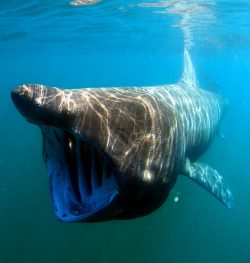select your film:


The basking shark is the second largest fish in the world after the whale shark. These gentle giants can reach lengths of over 10m. They’re highly migratory and are found all over the world in temperate waters. It prefers temperatures between 8 and 16 degrees. Basking sharks are easy to identify due to their huge jaw, which can open up 1m wide. They also have a large liver that provides buoyancy.
Despite their huge size basking sharks are harmless. They’re filter feeders, which means they’re diet consists of plankton. Their name comes from their habit of slowly swimming near the surface of the water. They’re also known to leap out of the water on occasion, peaking at up to 1.2 m above the surface.
Basking sharks have been fished for their liver oil, meat, and fins. They’re considered vulnerable to extinction due to their slow reproductive cycle. Basking sharks are in CITES Appendix II. Trade of basking sharks products is restricted, but they’re still landed as bycatch in the North Atlantic. They are protected in several countries in the North Atlantic.
Do you have images or videos of Basking Sharks?
Submit them to [email protected].
